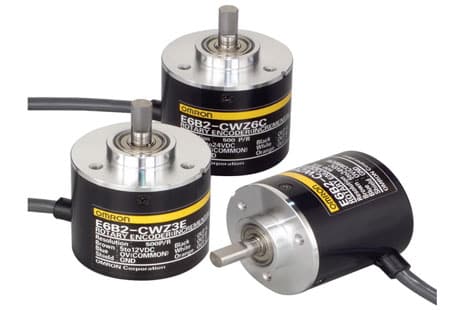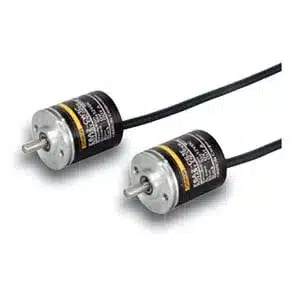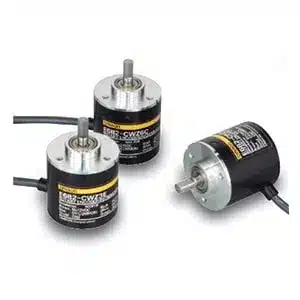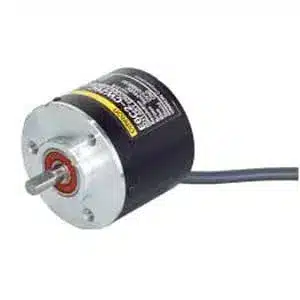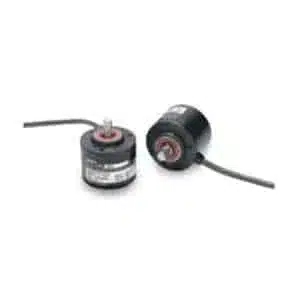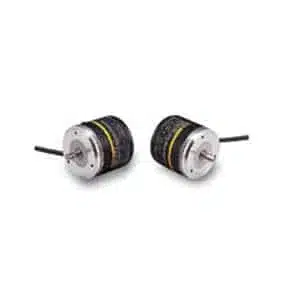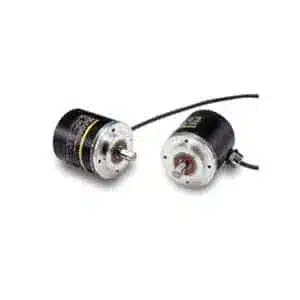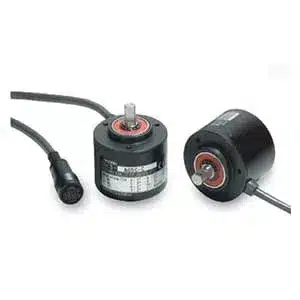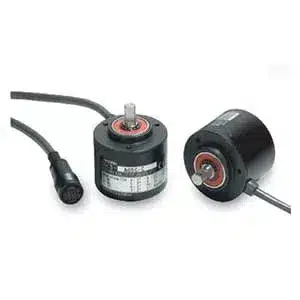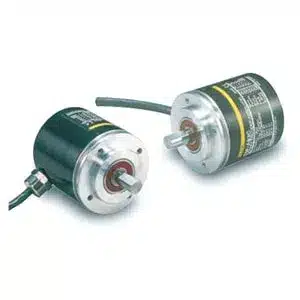Omron Rotary Encoders: Absolute, Linear & Shaft Encoder
IndMALL Automation delivers high-quality Omron Rotary Encoders, essential for gauging the position and speed of spinning shafts in industrial environments. Offering both Incremental and Absolute encoders, available in varied sizes, resolutions, and output options, they cater to diverse requirements.
IndMALL offers Competitive pricing that is guaranteed across all variants. Choose IndMALL for top-notch rotary encoders and contact us now to explore Omron’s extensive products.
Omron Rotary Encoders: E6A2-C
The Omron E6A2-C series Rotary Encoders are designed for peak performance, offering resolution outputs up to 500PPR with options ranging from 10 to 500PPR.
E6A2-C Series
Omron Incremental Encoder: E6B2-C
The Omron E6B2-C rotary encoder, with a 40mm diameter, delivers impressive outputs up to 2000PPR, adaptable to specific needs.
E6B2-C Series
Omron Incremental Rotary Encoder: E6C2-C
The Omron E6C2-C incremental rotary encoder offers up to 2,000 ppr resolution, features sealed bearings, an IP64 rating, and is available in pre-wired models.
E6C2-C Series
Encoder Incremental Omron: E6C3-C
Omron’s E6C3-C series, with a 50mm diameter, provides up to 3,600 ppr and epitomizes durability, also offering ready-to-use pre-wired options for users.
E6C3-C Series
Omron Linear Encoder: E6D-C
Omron’s E6D-C rotary encoder, boasting a 55mm diameter, is a premium model delivering outputs up to an impressive 6000 PPR for precise measurements.
E6D-C Series
Omron Hollow Shaft Encoders: E6H-C
E6H-C, optimal for complex installations, offers hollow shaft encoders and powerful measurements up to 3600 PPR, with additional options between 300 and 3600 PPR.
E6H-C Series
Omron Absolute Encoders: E6CP-A
The Omron E6CP-A, ideal for sensitive applications requiring precise positioning, features a 50mm diameter and boasts up to 16-bit/22-bit high-resolution output capabilities.
E6CP-A Series
Omron Absolute Rotary Encoder: E6C3-A
Omron’s durable E6C3-A absolute encoder, with a 50mm diameter, achieves up to 1,024 (at 10 bit) resolutions, offering various PPR selections from 6 to 1,024.
E6C3-A Series
Omron Absolute Encoder: E6F-A
The E6F-A model, with a 60mm diameter, provides a 1,024 resolution output and selectable pulse-per-revolution options ranging from 256 to 1,024.
E6F-A Series
The Omron rotary encoder translates the angular position of a shaft into either an analog or digital code, becoming indispensable in applications involving motion control, positioning, and speed monitoring.
Omron presents two principal types of rotary encoders: the incremental and absolute encoders. The Omron incremental encoder emits an output signal each time the shaft rotates through a specified angle, providing a budget-friendly option for applications that require only relative position information.
Conversely, the Omron absolute rotary encoder assigns a distinct output value to every shaft position, making it optimal for applications necessitating exact position and orientation data. These are available in various sizes to meet your requirements, and specialized options like the Omron hollow shaft encoder and Omron linear encoder are also accessible.
Omron encoders also offer varied mounting styles, including options for hollow shaft encoders and hollow shaft rotary encoders. These encoders feature a hollow bore, facilitating direct mounting onto a shaft, ensuring effortless installation while conserving space.
People Also Ask
What is rotary type encoder?
Understanding Rotary Type Encoder
A rotary type encoder is a special device. It helps machines understand position and motion. It looks a bit like a wheel. This wheel has special markings on it.
When the wheel turns, it sends messages. These messages tell a machine how much it has moved. This can control motors in robots, elevators, and more.
Rotary encoders are very important for control. They ensure that machines move exactly how they should.
In simple terms, a rotary encoder is like a guide. It tells machines how and how much to move, helping them act precisely.
What is a rotary encoder used for?
Uses of a Rotary Encoder
A rotary encoder is used for tracking the position of a shaft. It helps to tell machines how much something has turned. This turning is often related to movement and position.
In robotics, rotary encoders guide precise movements. They help robots know where their parts are. So, they move correctly and do tasks accurately.
In elevators, rotary encoders help with control. They make sure the elevator stops at the right floor. This ensures smooth and safe rides for passengers.
Summing it up, rotary encoders guide movement. They’re used in various machines to make sure they move just right.
What is the difference between rotary encoder and encoder?
Differences Between Rotary Encoder and Encoder
A rotary encoder is a specific type of encoder. It tracks and communicates turning or rotational movement to a machine. This device shares information about angles and rotations.
An encoder, in a general sense, has a broader meaning. Encoders can track movement, but not only rotation. They might track straight (linear) motion or speed too.
While all rotary encoders are encoders, not all encoders are rotary. Rotary encoders deal with turns, while encoders might handle different movements.
Simply, rotary encoders focus on rotational information. General encoders can handle various kinds of movement, including rotation.
What are the two main types of rotary encoders?
Two Main Types of Rotary Encoders
The first main type is “Incremental Rotary Encoders.” They track and report the motion of a rotating part. When the part moves, the incremental encoder sends pulses. Each pulse means a small movement.
The second type is “Absolute Rotary Encoders.” They always know and tell the exact position, even after the power is off. When power returns, they remember the last position without moving back.
In summary, rotary encoders come mainly in two types: Incremental, for counting movements, and Absolute, for knowing exact positions.
How many types of encoders are there?
Understanding Various Encoder Types
Encoders can be broadly classified into two main categories. These are “Rotary Encoders” and “Linear Encoders.” Each category manages different movements.
Rotary encoders handle rotational, spinning movements. They tell a machine about turns and spins, ensuring accurate circular motions.
Linear encoders, on the other hand, deal with straight, back-and-forth movements. They help machines understand how far something moves in a straight line.
So, there are mainly two types of encoders: Rotary, for spins and turns, and Linear, for straight-line movements. Both are crucial for precise machine operation.
How do I choose a rotary encoder?
Choosing a Rotary Encoder
First, think about what the encoder will do. Understand the movement you need to track. This helps pick between incremental and absolute encoders.
Next, consider the environment where it will work. Choose an encoder that can handle the conditions like dust, water, or extreme temperatures.
Check the encoder’s resolution, which is how precise it is. Higher resolution means it can detect smaller movements, offering more accuracy.
Also, consider the size and shape of the encoder. Make sure it fits and can be installed where it’s needed.
Lastly, think about your budget. There are various price options, so choose one that offers what you need without being too expensive.
In a nutshell, consider function, environment, precision, size, and cost when choosing a rotary encoder.
Get best deals on Omron Rotary Encoders at IndMALL Automation.

